 Written by Hulet Smith, OT
Written by Hulet Smith, OT
“If you find it in your heart to care for someone else, you will have succeeded.” -Maya Angelou
It's no secret that caregivers have one of the most demanding jobs around.
Providing care to your loved one can be rewarding, frustrating, exhausting, joyful, thankless, and challenging - all at the same time. So it comes as no surprise that one of the biggest challenges caregivers face is having time to take care of themselves.
If you are the caregiver of a loved one, it can be easy to forget about taking care of your own needs, since there are always more pressing and immediate concerns.
This leads many caregivers to experience what’s known as burnout. This is defined as a state of emotional, physical, and mental exhaustion, which is caused by prolonged stress.
If you feel overwhelmed, frustrated, emotionally drained, and unable to meet constant demands placed on you at work or at home, you may be experiencing burnout.
Burnout mimics the symptoms of depression including a change in mood from positive and caring to negative and apathetic. It occurs when caregivers either don't get the help they need, or if they do more than they are able.
This can cause not only your physical and mental health to deteriorate, but also lessens your ability to care for your loved one(s). That’s why it’s absolutely essential that you recognize these symptoms in yourself and take steps to heal.

Burnout only happens when people become overwhelmed, so it’s important that you recognize you can’t shoulder all of this alone.
Find someone you trust, maybe a friend, a family member, a co-worker, or even a neighbor, and talk with them about your feelings and frustrations.
If you don’t feel comfortable venting to anyone you know, speaking to a professional like a therapist, social worker, or clergy member is a great solution. These people are trained to help you through a range of emotional needs.
If you’re saying, “All of that sounds great, but when am I supposed to find the time?” Find a friend or family member to tag in and care for your loved one, or you can take advantage of respite services.
Respite care is specifically designed to provide a break for caregivers who need help. This can range from a few hours of care to a short, temporary stay in a nursing home or assisted living facility while you take time to sort out your own health.
One of the most common causes of caregiver burnout is the feeling of hopelessness that comes along with caring for an aging loved one or someone with a degenerative condition.
Providing care for someone who will not get better no matter how hard you work can be heartbreaking and exhausting, and it’s important to set realistic goals for yourself and your caregiving.
The best thing you can do in this situation is to educate yourself. The more you know about the illness, the more effective you will be in caring for the person with the illness.
This way, you can be realistic about your loved one’s disease, as well as understand the various ways they may need help now and in the future. Painting an accurate picture of the situation will also help you check in with yourself and your feelings.
Having negative feelings like frustration, anger, and feelings of unfairness towards your responsibilities or the person you are caring for is normal and doesn’t mean you are a bad person or a bad caregiver.
Setting realistic goals and expectations for yourself and your caregiving can help you feel like you’re providing good quality care, while also helping you to accept your limitations. This can encourage you to reach out for help when you need it and acknowledge negative feelings when you have them.
Just because you’re busy caring for someone else doesn’t mean that you can forget about yourself. If you’re not doing things like getting enough rest, eating proper meals, or attending to your own health you can’t provide great care.
Remember, your health is just as important as that of the person that you’re caring for, and you can also use activities designed to keep them healthy and active as a way to keep yourself healthy.
Jogging with a child in a stroller, going on a walk while pushing their wheelchair, or having your loved one help you in the garden or kitchen can also be some great ways to stay healthy as a team.
You can also stay healthy by taking time for yourself. Go on long walks, do yoga or stretching while watching TV or listening to music, or get out of the house and go to a group fitness class.
Your body is taking a major hit by being a caregiver, and it’s important that you’re kind to it. Another important way to do this is through proper nutrition. If you’re already cooking nutritious meals for your loved one, this is simply a matter of making sure you’re eating too.
If not, you may want to consider looking into cooking classes, maybe even something you and your loved one can do together, or you can try a meal delivery service like Blue Apron, Hello Fresh, or Sun Basket. These boxes deliver everything you need to make healthy meals at home in pre-measured packets with easy to follow instructions.
Finally, caring for your mental health is just as important as your physical health. In this vein, it’s important to take time to relax and be kind to yourself. Even if it’s just an hour or two a day in the morning or before bedtime, you have to set time aside for yourself.
Remember, taking care of yourself is not a luxury; it is an absolute necessity if you're going to be an effective caregiver. You have to know your limits and really check in with yourself and your personal situation. This is an important part of being able to recognize and accept your potential for caregiver burnout.

If your loved one needs help with movement, balance, or safety, it is important to make sure to use good body mechanics. This means keeping your back in a safe and aligned position, bending your knees and hips instead of your trunk, and using equipment to minimize the strain on your body.
It also means using the right tools to minimize the amount of pulling, lifting, reaching and straining you need to do throughout your day.

Another huge concern for caregivers is not only the physical demands, but the concerns for your loved one’s safety. Your loved one may have poor memory or poor cognition, making it difficult for them to choose and act safely.
They may also have certain conditions that can cause an emergency medical situation at any time, like a seizure disorder or serious heart condition.
In these cases, it may feel like you can't leave them alone for even a second, and even going to the bathroom for a moment may wrack you with worry.
Thankfully, there are ways to help you get peace of mind while still taking time for yourself.

Dear caregiver, be gentle with yourself - you are doing the best you can.
Have your loved one help you. It encourages independence and you get to do less lifting.
Look for programs and resources that could provide respite or support for you
Ask for help, be specific with what you need, and take people up on it when they offer.
Finally, learn the ways that you can recharge your batteries and get yourself back to being able to fully give the care your loved one needs. Share with us your ideas for keeping yourself healthy – both physically and mentally – as you face the daily challenges of being an amazing caregiver!
For more resources on how to be a great caregiver and get help when you need it, check out our full library of articles on Caregiver University. And, be sure to come visit RehabMart for all your medical equipment needs.

Co-founder/CEO of Rehabmart, Pediatric Occupational Therapist, husband, and father. Passionate about connecting special needs kids with superb nutrition, sensory integration, and complementary health strategies. Excited about Rehabmart's mission to become the premier online educational platform which empowers caregivers by spotlighting innovative devices and interventions to achieve optimal patient response and recovery.